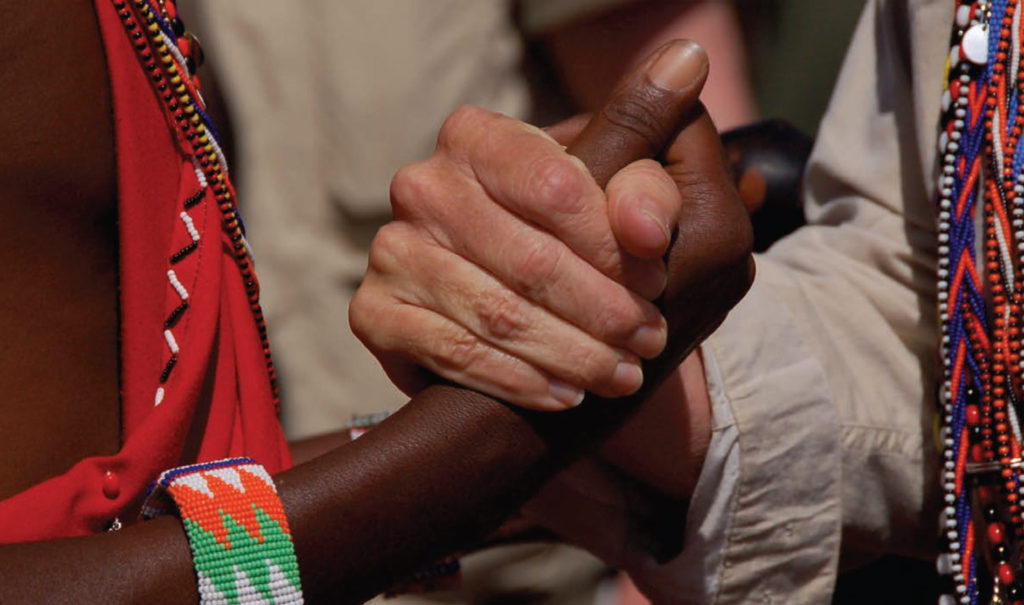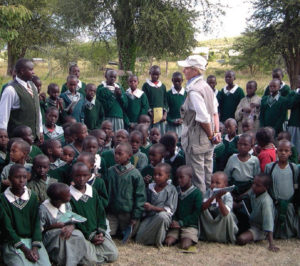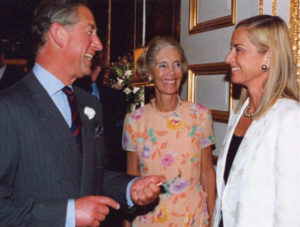Out of Oak Brook and into AFRICA

Reute Butler carries on a family tradition that extends to Kenya
By Kerrie Kennedy
With her major Friends of Conservation (FOC) fundraiser, The Conservation Ball, on the horizon, Reute Butler, whose family founded Oak Brook, spoke about her family legacy of philanthropy, and her commitment to FOC, which works directly with Kenya’s Maasai community and other stakeholders in the renowned Mara-Serengeti ecosystem, promoting sustainable ways of living in harmony with wildlife and ecosystems. From helping to create direct sources of income from tourism, beadwork and beekeeping, to preserving existing forests with alternative sources of energy and “reforesting,” to conservation education efforts for adults and children, FOC—and Reute’s mother Jorie Butler Kent—was a pioneer in the development of Community Conservation work in the 1980s and continues that work today. Hinsdale Magazine recently caught up with Reute Butler, a successful art photographer as well as conservationist, to find out more.
How did Friends of Conservation come to be?
My mother, Jorie, founded FOC in 1982, carrying on the philanthropic tradition of our family and our commitment to conservation. She had a house in Kenya for 40 years, and felt strongly that she should give back to that home and to the birthplace of Abercrombie & Kent, which was originally begun by her business partner Geoffrey Kent’s parents in Kenya in 1962. She and Geoffrey developed Abercrombie & Kent into the luxury travel company that it is today, and they are co-owners of the company. My mother and I run Friends of Conservation together; Geoffrey is very supportive, and it gives us great pleasure to work together on something so rewarding.
Tell me about the work Friends of Conservation does.
Friends of Conservation is a small, grassroots organization. Our work focuses on protecting the Maasai Mara Region, Kenya’s portion of the famous Mara-Serengeti ecosystem, which spans the Kenya-Tanzania border, and is home to many hundreds of species. Each year, during the wildebeest migration of more than two million animals, herds in the hundreds of thousands migrate from the Serengeti National Park in Tanzania in search of the green pastures of the Maasai Mara National Reserve in Kenya, and then back south to the Serengeti. It is the largest remaining mammal migration in the world, and this area is really crucial to the survival of the entire ecosystem. It is also home to the Maasai people, who have lived here for longer than anyone can remember.

Reute Butler works with FOC conservation club junior members at Siana Primary School, Eastern Maasai Mara
Why is education so crucial?
It is important for the Maasai to learn how to preserve their beautiful wild-land, because the income it brings them from tourism sustains their culture. If they sell or destroy the land, their major source of income will disappear, as will their culture. This would also negatively impact the economy of Kenya—tourism is the largest income-producing sector in Kenya, and the Mara is the most visited destination in East Africa. Our challenge is to teach the Maasai why it’s valuable to preserve their beautiful habitat, and to look at the wildlife as a resource, rather than [as] competition for resources. It’s hard for them to see the bigger picture when their livestock [have] just been killed by a leopard, or their maize field [has been] trampled by an elephant, but this is exactly where we come in, with meetings and our human wildlife conflict workshops, explaining the value of their wildlife to them, and providing common-sense solutions to livestock predation. We concentrate our efforts in the Eastern Maasai Mara, in six communities and in our FOC conservation clubs in 12 schools. Our 13 FOC community scouts are volunteers; they are spokespeople for wildlife and their communities, and help identify poachers for the Kenya Wildlife Service. In 2014 and 2015, there were 75 arrests and 31 successful prosecutions thanks to their work.
Why is educating Maasai about preserving their wildlife and open lands important to us in the West?
That is a good question—one I’m asked often. The answer is unfortunate: it’s because of terrorism. The rampant poaching of elephant and rhino in East Africa has been funding terrorist groups and destabilizing all of East Africa. They are responsible for the dreadful bombings in Kenya, and this is bad for the West, as these groups hate us. Every day in Africa, 100 elephant are slaughtered for their tusks to feed the voracious Asian appetite for ivory. If this keeps up, the prediction is that Kenya’s elephant will be gone in fewer than ten years, and the African elephant will become extinct in the wild. Thank heaven the U.S. and now China both recently banned trade in ivory and other products. We have a prayer now of saving the elephant in the wild. We will soon know if these bans are working.

The Prince of Wales, Royal Patron FOC, FOC founder and International Chairman Jorie Butler Kent at St. Jameses Palace after a cocktail reception the prince hosted for FOC in 2002.
What are some of the important projects you’ve worked on?
Since our inception, we’ve planted close to half a million trees in the Mara, and estimate a good 350,000 of those trees have survived. Deforestation is huge problem; wood is often used for fuel and building materials, and forests are decimated. One of our wildly-popular projects is our Rhino Watch trip. We take about 28 students and a couple of teachers in our bus into the reserve to have them see first-hand what the tourists see, and to teach them about wildlife and their heritage. The Mara is unusual—it’s a reserve, and is actually owned by the local people, not the government; so all of the income from tourism goes directly to them to build schools and clinics and other things they need. It is especially important that they understand the value to them of keeping their land undeveloped and their wildlife thriving. Many young people who have passed through our conservation clubs have gone on to find jobs in the tourist industry, and one enterprising group of young men [has] gone on to form the Maasai Mara Guides Association with our support.
What can people expect at The Conservation Ball in October?
It will be held at the Four Seasons in Chicago. My co-chairs are Vonita Reescer, Kristina McGrath, Kyle de Santis and Mitchell Hatcher— it’s a great group. [Our] sponsors are James Drury Partners and American Airlines. Our guest speaker is my great friend, conservationist John Rendall, of “Christian the lion” fame. Christian was a lion cub which John and his friend Ace bought in 1968 at London’s Harrods in the pet store. He was horrified to see a lion cub for sale. Born Free had just come out that year, and by coincidence, John met the stars. Through them, John was able to make sure that Christian was rehabilitated into the wild very successfully by the legendary George Adamson. John will be helping me with the wildlife presentation that I always do for our guests. It gives people a very visceral connection to and understanding of the work we do—it is for these beautiful beings’ cousins in the wild and for the Maasai, who own their habitat, that we do this work. At past events, we’ve had a cheetah, a lion, a snow leopard, and a zebra—if you want to know what we will have this year, come to The Conservation Ball.
How often do you visit Kenya?
Mother goes out a couple of times a year—I go out every other year. I often take groups of friends to Kenya to see our work. Anyone who wants to go can get in touch with me, and I will see that they are able to see our work. A visit to beautiful Africa will change your life!
*Photos provided bv Friends of Conservation, Reute Butler and Manuela Hung
